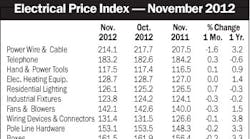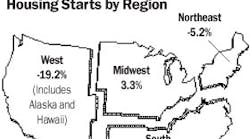Latest from Mag
People - Dec 21, 2012
Obituaries - Dec 21, 2012
November EPI Index Shows No Change
Housing Starts Dip 4% in November
Electrical Marketing - December 21, 2012
Around the Industry - Dec 21, 2012
Trying to escape insanely high home prices in California and other big-dollar West Coast markets, new residents are flocking to Boise, Idaho, and the suburbs of Ada and Canyon Counties in its nearby mountains and valleys.
“Residentially, the Boise area has been a booming area for some years,” said Mark Lorimor, manager of WESCO Distribution Inc.’s Boise branch and a long-time resident of Boise. “A lot of folks are moving into the valley from all points, but in particular from California.”
Boise is an attractive alternative to Californians because homes and land are comparatively less expensive. But with land prices now rising in Boise, residential and commercial growth has been moving west 10 to 20 miles, first to Meridian and Eagle, Idaho, and more recently to Caldwell, Nampa and similar Idaho communities. Nonetheless, urban condos are quickly becoming part of the downtown Boise skyline, with more than 300 units in six projects either in the planning or early-construction stages, according to Real Estate Business Online.
“Most of the growth that’s being experienced right here residentially and commercially really is in Canyon County, adjacent to Boise’s Ada County,” says WESCO’s Lorimor. “Boise has probably seen its heyday in growth. Ada County does not have a moratorium on building, but the pricing has become so exorbitant that a lot of the construction has moved west of Boise into the next county. They have more available land and those municipalities wanted to get on the bandwagon.”
Boise’s residential market began cooling off this summer. One of Lorimor’s friends works for a lumber distributor that sells to retail lumberyards in southern Idaho and eastern Oregon. That distributor’s employees were working 12-hour shifts, delivering lumber from 5 a.m. or 6 a.m. until 6 p.m. or 7 p.m. every evening. Now, many of the lumberyards are letting their crews leave by noon. “That shows you the housing market has slowed down,” he says.
This year, the region’s 7,650 total building permits (single-family and multi-family) year-to-date through October are down 23 percent from October 2005. Single-family building permits are down 27 percent over the same period a year ago, at 6,800.
Kent Young, a principal of Blomquist, Densley & Young, a Salt Lake City-based manufacturers’ rep, has covered the Boise market for 26 years. He says the high price of building lots has slowed down homebuilding quite a bit, but the market is still active in Nampa and Caldwell because the land is less expensive and the commute is still not too long from downtown Boise. Young also points to the Donnelly-McCall area where the residential market is still strong, with an upscale four-season resort community being developed, and the Hailey-Sun Valley area east of Boise, where construction of second homes has been solid.
While the residential market is slowing down in much of metropolitan Boise, there is no shortage of commercial/institutional construction projects such as schools, hospitals, strip malls and wastewater-treatment facilities. The city of Meridian plans to build a “green” city hall and will apply for Leadership in Energy and Environmental Design (LEED) accreditation when the building is complete, according to Keith Watts, purchasing agent for Meridian and contract manager for the new City Hall building. LEED design standards promote the use of energy-efficient or recycled building materials and systems. The city plans to request bids for the new city hall by the second week of February and wants to complete construction by early 2008.
Despite the anticipated slowdown in residential building, sales of electrical products in the Boise market should grow in 2007. Herm Isenstein, president, DISC Corp., Orange, Conn., forecasts that electrical distributors in the Boise region will sell approximately $153 million in electrical products this year, a 19-percent increase over 2005. DISC’s 2007 forecast for distributor sales in Boise is $175 million, a 14.4-percent increase over 2006.
Lorimor is still expecting a busy 2007 based on what he is seeing in the residential market. “With the schools and all the commercial stuff that is going to come out to bid here in early 2007, I see at least the next year as being pretty brisk for us,” he says. “When you have that kind of residential influx, all sorts of services and businesses grow up around those new subdivisions.” He believes if the residential market remains depressed throughout 2007, the commercial market could sputter in 2008.
Because of the huge residential influx in recent years, municipal services including wastewater-treatment plants and roadway work are scrambling to catch up. There is also pent-up demand for schools in the area. According to the city of Boise’s Web site, it currently has 34 grade schools, nine junior high schools and five high schools. Several large school projects will soon break ground. One distributor expects to see “an exorbitant amount of new school construction in 2007.” “The biggest high school in Idaho is Rocky Mountain High School in Meridian, which is under construction now,” says WESCO’s Lorimor. “Columbia High School just opened up this fall. Many other elementary schools, junior high and high schools are on the drawing boards.”
Young of Blomquist, Densley & Young has seen Boise’s industrial base change from being focused strictly on agricultural and food processing businesses to include much more semiconductor manufacturing. Today, Boise is a world leader in the manufacture of high-tech microprocessors. Many large regional, national and international companies are headquartered in Boise, including Simplot Corp., Boise Cascade, Albertsons, Micron Technology Inc. and Hewlett-Packard, and several are expanding their facilities. Micron Technology, the largest employer in Boise, and Photronics Inc. are working together on a new photomask fabrication facility in Boise that will represent an investment of up to $150 million over the next three years.
Retail construction is strong, too. According to Colliers International, Boston, a global affiliation of independently owned real estate services firms, retail activity will be strongest in the Boise region’s Canyon County at the Treasure Valley Marketplace and the Wal-Mart/Sam’s Club developments. Including the anchor retailers, over 800,000 square feet of retail will be under construction by year’s end. With the success of an area called “BoDo” in downtown Boise, Colliers says more mixed-use projects will be announced with retail office and residential components. Meridian will have at least two new projects, with Kohl’s anchoring one of the developments.
John White, a principal of John White and Associates Inc., a manufacturers’ rep in Salt Lake City, has been covering the Boise market for 25 years and says all segments of the market in Boise and its neighboring communities are doing well, and that Idaho is flush with money from out-of-state investors. He says the food processing, agriculture and potato businesses are very strong. Unemployment is in the 3 percent range. With the shortage of skilled workers, one of Boise’s biggest future challenges will be finding workers to keep construction going, White says. “The labor market is going to be the problem that you’ll see with us. Boise can’t get people to take care of some of these jobs.”
Manpower remains a concern across industries. “There just are not enough qualified tradesmen to sustain much more growth,” says Young of Blomquist, Densley & Young. “The gas and oil fields in Wyoming are paying high wages and pulling workers out of Idaho.”

